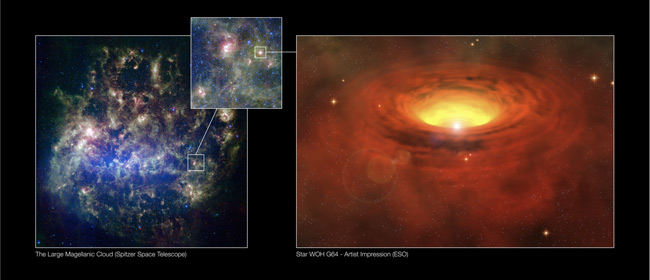Fat Star's True Small Nature Revealed

The mystery of a bloated but strangely cold star has beenresolved by Europe?s Very Large Telescope.
The red supergiant in a nearby galaxy is actually about halfas massive as what astronomers previously thought, which explains its cooltemperature.
"Previous estimates gave an initial mass of 40 timesthe mass of the sun to [the star] WOH G64,? said Keiichi Ohnaka, leadastronomer on the study at the Max-Planck Institute for Radio Astronomy inBonn, Germany. ?But this was a real problem as it was way too cold, compared towhat theoretical models predict for such a massive star. Its existence couldn'tbe explained."
Astronomers had assumed that a spherical cloud of gas anddust partially hid the entire star, and adjusted their calculations of thestar?s brightness and mass by overestimating from what they could see. However,the VeryLarge Telescope in Chile found the star ringed instead by a doughnut-shapedtorus of expelled gas and dust.
"We are looking into the torus from top," Ohnakatold SPACE.com. The top-down view of the doughnut hole means astronomerscan see a lot more of the star?s light than they had once thought.
The revised calculations suggest the star is half as brightas previous estimates and has less mass — just 25 times as much mass as thesun.
The star has also apparently undergone a crashdiet that has resulted in "heavy mass loss," said co-researcherMarkus Wittkowski from ESO at the Max-Planck Institute. That feeds the growingdoughnut of gas and dust surrounding the star.
Get the Space.com Newsletter
Breaking space news, the latest updates on rocket launches, skywatching events and more!
"We estimate that the belt of gas and dust thatsurrounds it contains between three and nine solar masses, which means that thestar has already lost between one tenth and a third of its initial mass,?Wittkowski said.
The gas belt has expanded to almost a light-year across indiameter, while the star still appears 2,000 times as large as our sun despiteits weight loss.
"Everything is huge about this system. The star itselfis so big that it would fill almost all the space between the Sun and the orbitof Saturn," Ohnaka said.
Ohnaka and Wittkowski gathered the data by combining twotelescope units at the Very Large Telescope to form a VLT Interferometer, whichhas a resolution equivalent to a 60-meter virtual telescope.
This represents the first time that any telescope has madeout the finer features of an individual star in a neighboring galaxy, peeringinto the LargeMagellanic Cloud, which lies 163,000 light years away.
- Video: Follow New Horizons on its Jupiter Flyby
- The Wildest Weather in the Galaxy
- Image Gallery: Jupiter's Moons
Join our Space Forums to keep talking space on the latest missions, night sky and more! And if you have a news tip, correction or comment, let us know at: community@space.com.
Jeremy Hsu is science writer based in New York City whose work has appeared in Scientific American, Discovery Magazine, Backchannel, Wired.com and IEEE Spectrum, among others. He joined the Space.com and Live Science teams in 2010 as a Senior Writer and is currently the Editor-in-Chief of Indicate Media. Jeremy studied history and sociology of science at the University of Pennsylvania, and earned a master's degree in journalism from the NYU Science, Health and Environmental Reporting Program. You can find Jeremy's latest project on Twitter.









